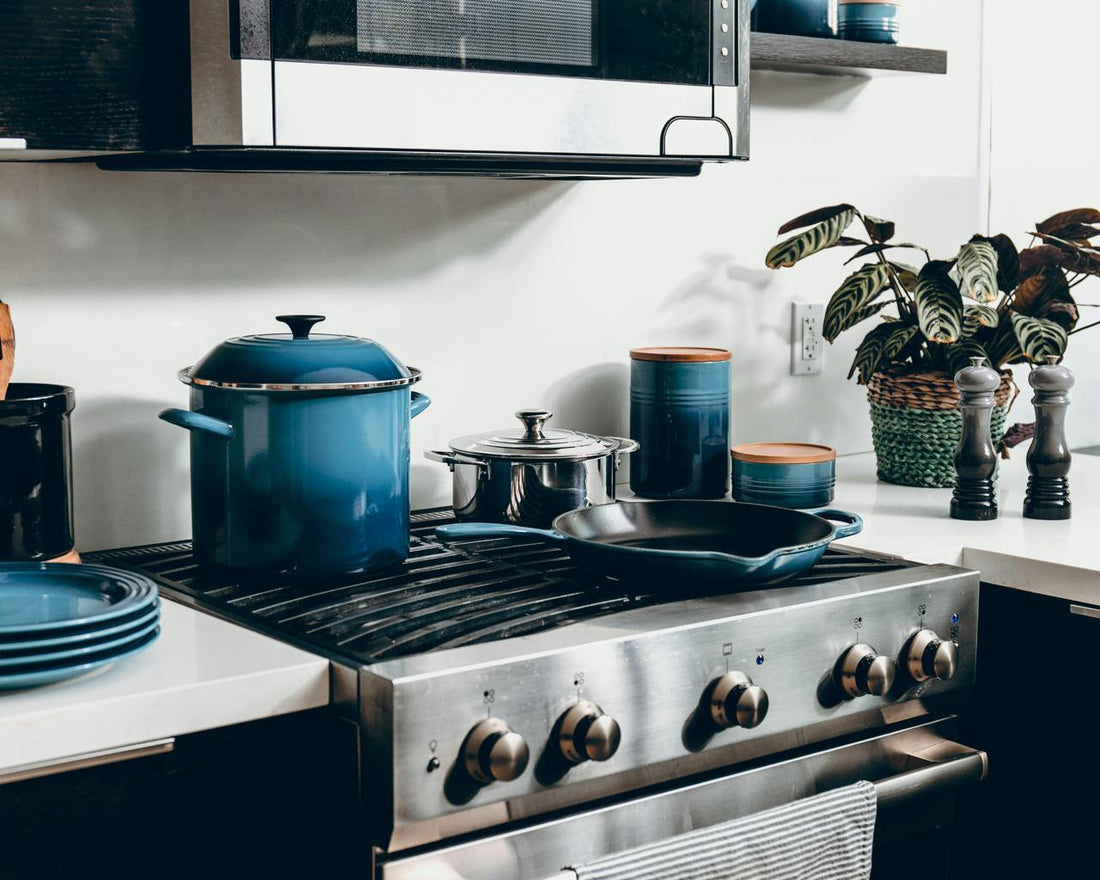
Choosing the Best Cookware for Your Kitchen – How to Do It
Share
It's a jungle of deciding with so many types of cookware available. But picking the best pieces for your cooking style is a well-thought-out decision that you should make on your journey to delicious meals. This guide will help you make informed decisions, whether you are starting from scratch or upgrading your kitchen. We'll break down three key considerations into chapters: materials, functionality, and maintenance.
Understanding Cookware Materials

Different materials are probably the most critical aspects when it comes to the selection of cookware. Each is a different type, as there exist a number of properties that make every food cook differently, clean differently, and last for different periods.
Stainless SteelDurable, non-reactive, and don't rust or corrode. Excellent for browning, sautéing, and deglazing.
Cons: Pure stainless steel is not a very good heat conductor; hence, pans made with an aluminum or copper bottom will distribute the heat more evenly.
Iron
Pros: great heat retention, ideal for slow cooking, frying, and baking. Cast iron goes seamlessly from the stovetop into the oven and only gets better with time and seasoning.
Disadvantages: Heavy and consume a lot of maintenance because one needs to grease it regularly to prevent rusting. To maintain the nonstick properties of cast-iron pans, they have to be seasoned.
Non-sticking
Pros: Very easy to clean; excellent for cooking with a non-stick quality; the most appropriate type for eggs and pancakes, for instance. The best option is when low-fat meals need to be prepared because you will have to use less oil.
Disadvantages: Non-stick finishes degrade with time and high heat. Avoid using metal utensils; it scratches the surface.
Copper
Advantages: Excellent conductor of heat; very precise control over temperature is possible. Lining is often of stainless steel to prevent reaction between food and metal. This is expensive, always requires polishing to look good, and copper cookware is reactive with acidic foods, which may affect the taste.
Ceramic
Pros: Non-stick and chemical-free, such as PTFE and PFOA. Besides, it is eco-friendly and heat-resistant for high-heat cooking.
Disadvantages: The non-stick will come off eventually, and is not durable as much as a metal one.
Choosing Cookware for the Job

Cookware functionality is about having the right tool for the job. Some pieces can do it all, while others have specific tasks. Here's how to build a functional cookware collection.
Skillets/Frying Pans
Most suitable for fast cooking tasks: sautéing, frying, and browning. Non-stick or cast iron skillets will perform best for everyday needs.
AYK Suggestion: Go for AYK's stainless steel skillets with an aluminum core that distributes the heat evenly.
Saucepans
Perfect for making sauces, boiling pasta, or heating soups. Choose a size that will fit the amount of food you normally cook.
NOTE: A pan with a well-fitting lid forms a mini-environment that retains heat and moisture-perfect for simmering.
Dutch Oven
Essential for any slow-cooked meal, whether stew, braise, or casserole. Cast-iron Dutch ovens go directly from stovetop to oven and are thus very versatile.
AYK Recommendation: AYK enamel cast-iron Dutch oven provides excellent heat retention and comes in a range of colors to fit your kitchen.
Stockpots
Ideal for cooking large quantities of soup, stew, or pasta. Stockpots are deep and usually have a lid to cover them and help retain moisture.
A must for those who cook for an army on the regular.
Roasting Pan
Good for roasting meats and vegetables. A pan with a rack allows air to circulate under the food, ensuring even cooking. Look for a heavy-duty roasting pan that could double as a baking dish.
Care for Your Pots and Pans So They Last Longer

Properly caring for and maintaining cookware will help you to get the most out of your cookware. Each type of material has different requirements, so knowing how to take care of your investment will pay dividends in years to come.
Cleaning
Sprinkling baking soda and water mixture will work wonders. - Stainless Steel: Soak in warm water to loosen food particles before scrubbing.
- Non-Stick: Clean with a soft sponge or soft cloth to avoid scratches. Avoid the use of metal utensils and high heat, which can damage the non-stick coating.
Cast Iron Never use soap. Clean in warm water with stiff brush after cooking, and dry at once. Lightly grease to prevent rust.
Copper: Regular polishing is needed to maintain the brilliance. For cleaning, lemon and salt mixed in appropriate portions should be used to remove tarnish naturally
Storage
Store the pots and pans in a cool, dry place so that they do not rust or change shape. One can use a pan organizer or hanging rack to save space and protect against scratching of items against each other. - Stack cookware with protection pads between them when space is a factor.
Seasoning
Seasoning is done to cast-iron cookware to maintain the non-stick surface. Cleaning and then applying a thin layer of oil should be done; afterwards, it should be heated in an oven. This builds up protective layers that avoid rusting and are advantageous in cooking.
Damage
Prevention Also avoid overheating of non-stick pans and the use of metal utensils on sensitive surfaces. All cookware can warp when there is a sudden temperature change, such as placing a hot pan under cold water. Conclusion: Knowing your cookware, selecting the right tools for jobs, and taking care of them means having a kitchen that's truly set up for success and will continue to produce great meals for years to come. Whether you're a beginning cook or a seasoned chef, an investment in the right cookware will elevate your cooking experience.
Come check out the quality options at AYK, About Your Kitchen, for some cookware that puts together performance and durability with style, fitting for any kitchen.





